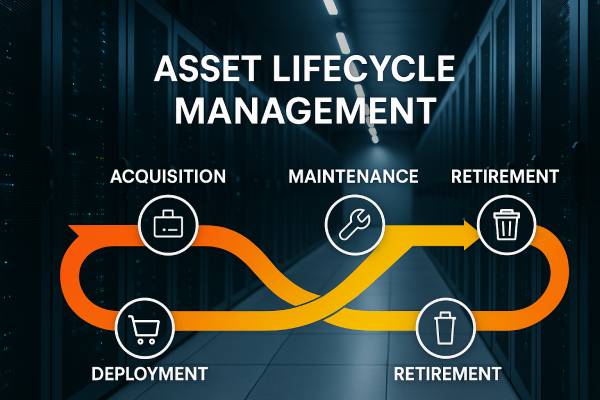Updated on April 18th, 2025
Data Center Infrastructure Management (DCIM) Software
Data Center Infrastructure Management (DCIM) is a category of software solutions designed to monitor, measure, and manage data center IT equipment and supporting infrastructure. DCIM tools provide data center operators with a holistic view of their facility’s performance, helping them optimize efficiency, reduce costs, and improve capacity planning.
Key Functions of DCIM
- Asset Management: DCIM solutions track and manage both physical and virtual assets within the data center. This includes servers, storage devices, networking equipment, and other critical infrastructure components. Effective asset management ensures optimal resource utilization and helps prevent over-provisioning or underutilization of assets.
- Capacity Planning: By analyzing current usage trends and predicting future needs, DCIM aids in capacity planning. This helps data center managers forecast and allocate resources effectively, avoiding the pitfalls of over-provisioning or under-provisioning, which can lead to unnecessary expenses or resource shortages.
- Energy Management: DCIM tools monitor and optimize power consumption within the data center. By identifying energy inefficiencies and implementing strategies to reduce power usage, DCIM helps lower energy costs and minimize the carbon footprint of data center operations.
- Environmental Monitoring: Keeping track of environmental factors such as temperature, humidity, and airflow is crucial in preventing hardware failures. DCIM provides real-time environmental monitoring, alerting operators to adverse conditions that could damage equipment or reduce efficiency.
- Change Management: DCIM facilitates the documentation and management of changes within the data center environment. This includes tracking hardware upgrades, software updates, and configuration changes, ensuring compliance with regulatory requirements and maintaining a detailed audit trail.
- Real-time Monitoring and Alerts: Continuous monitoring of systems and services allows DCIM to provide real-time insights into the health and performance of data center infrastructure. Proactive alerting enables operators to address potential issues before they escalate, ensuring maximum uptime and reliability.
Benefits of DCIM
- Improved Efficiency: DCIM streamlines data center operations by reducing manual processes and automating routine tasks. This enhances the productivity of data center staff and allows them to focus on more strategic activities.
- Enhanced Visibility: Providing a comprehensive view of the entire data center environment, DCIM facilitates better decision-making by offering insights into asset performance, capacity utilization, and environmental conditions.
- Cost Savings: By optimizing resource usage and reducing energy consumption, DCIM helps lower operational costs. Additionally, efficient management practices extend the lifespan of equipment, further contributing to cost savings.
- Risk Mitigation: DCIM enables proactive identification and resolution of potential issues, reducing the risk of unexpected failures and downtime. This enhances the overall reliability and availability of data center services.
Problems DCIM Solves
- Fragmented Systems and Data Silos: Before DCIM, data centers often relied on disparate systems and tools that were not integrated, leading to data inconsistencies and inefficiencies. DCIM consolidates these systems into a unified platform, ensuring data integrity and providing a single source of truth.
- Inefficient Resource Utilization: Manual tracking and management of resources often resulted in suboptimal utilization. DCIM optimizes the use of space, power, and cooling resources, balancing workloads and preventing bottlenecks.
- High Operational Costs: Routine tasks and manual interventions increased operational costs. DCIM automates these processes, reducing labor costs and improving efficiency. Additionally, energy management features lower power consumption, further reducing expenses.
- Compliance and Regulatory Challenges: Ensuring compliance with industry standards and regulations was challenging without a centralized system. DCIM simplifies compliance by providing detailed documentation, audit trails, and automated reporting, helping data centers meet regulatory requirements.
How Problems Were Solved Before DCIM
Before the advent of DCIM, data centers faced significant challenges in managing their infrastructure.
Manual tracking and spreadsheets were commonly used to monitor assets and resources, leading to errors, maintenance difficulties, and a lack of real-time insights. This approach was time-consuming, prone to inaccuracies, and hindered the ability to make informed decisions quickly.
Additionally, data centers relied on disparate tools and systems that were not integrated, resulting in data silos and inefficiencies. The lack of a unified platform made it challenging to obtain a holistic view of the data center’s performance and health, hindering the ability to optimize operations and plan for future needs effectively.
Maintenance practices were often reactive rather than proactive, with operators addressing issues only after they had already caused disruptions. Without predictive insights, data centers were at risk of unexpected failures and downtime, impacting the overall reliability of their services.
Furthermore, the lack of real-time insights impeded decision-making processes, as operators had to rely on outdated information to manage their infrastructure. This limited visibility made it difficult to identify potential issues proactively and optimize resource utilization effectively.
The adoption of DCIM solutions has revolutionized data center management by providing a comprehensive and integrated approach to monitoring, managing, and optimizing infrastructure.
Key Advantages of DCIM
The advantages of implementing a DCIM solution extend to saving time, boosting productivity, and cutting costs.
With remote access to asset information, Data Center Managers can effortlessly monitor space, power, and cooling resources in real-time.
Detailed insights into asset specifications and connectivity allow for precise capacity planning, right down to individual ports or rack units.
Critical capacity bottlenecks are swiftly identified, reducing the likelihood of failures.
Managing reservations, relocations, additions, and modifications becomes seamless.
As streamlined processes and workflows are put in place, employee efficiency and satisfaction soar, ensuring smooth and high-quality changes within the data center.
DCIM offers a revolutionary approach to overseeing and enhancing data center infrastructure. Through real-time monitoring, efficient asset management, strategic capacity planning, and environmental oversight, DCIM elevates operational performance, visibility, and productivity.



